
|   |

|   |
Indian Traditional Jewellery book launch, Pratishruti's Gopini Prem and Bhaskar Rao Sammelan - Manjari Sinha e-mail: manjari@sinha.com April 27, 2024 BOOK LAUNCH Photos courtesy: Ehsaas Ehsaas and Shubhi Publications launched Dr Alka Raghuvanshi's last written book 'A Rendezvous With Indian Traditional Jewellery', curated by Manisha Gawade with photographs by Avinash Pasricha, on the occasion of the author's 63rd birth anniversary. A senior columnist and author of many books, Alka was on the editorial teams of the Indian Express, the Times of India and the BBC, where she consistently wrote to cover literature and the entire spectrum of the arts including dance, music, theatre, painting and crafts. Her book gives an overview of the main styles of traditional gold and silver jewellery in their regional variations of inspirational and aspirational journeys. It is like a peek via female gaze into the intriguing world of the feminine through the microcosm of ritual, marital and fertility symbols, caste hierarchies, the oneness with nature, the economics of an agrarian society and the sheer perfection of craftsmanship. And yet while the consumers and to a certain extent designers may have been women, the creators of most jewellery continue to be men. In this sense perhaps this book is different from most others on this subject. It has focused on main traditional forms like the Kundan, Jadau, Meenakari and the South Indian temple jewellery. It doesn't claim to be the last word, especially in the Indian context, where tradition is perceived as a flowing river, changing, expanding, and intensifying to enfold the incredible variations within its fold. The book was released by Amitabh Kant, former CEO Niti Aayog and D Sachchidanand Joshi, Member Secretary IGNCA, at the flower-bedecked Seminar Halls of the IIC. Speaking on the occasion, Amitabh Kant acknowledged the book as "Alka Raghuvanshi's final masterpiece, crafted with love and dedication, immortalising the enduring beauty of Indian jewellery." He further said, "Her legacy continues to shine like these timeless pieces, inspiring craft and culture that transcend time and space, reminding us that true beauty lasts forever!" 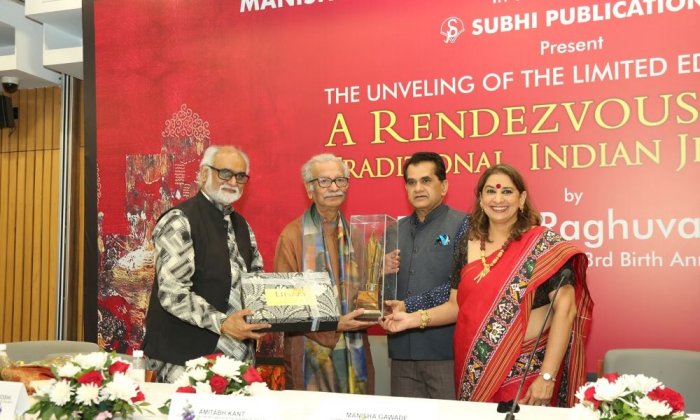 Dr. Sachchidanand Joshi, Prof. Niren Sengupta, Amitabh Kant, Manisha Gawade Paying a heartfelt tribute to her sister, Manisha Gawade, Director Ehsaas, felt satisfied for being able to do justice to Alka's last work, design and curate it, and bring it in print form. "Legends always live on, and so will she, through her work, and will continue to inspire millions across the globe. This show is to honour the legacy of an extraordinary individual, and my beloved sister, Dr. Alka Raghuvanshi!" Dr Sachchidanand Joshi praised India's cultural strength and the rich diversity of its traditional jewellery, written about in this book. 'The elegance of craftsmanship and range of creativity are seen in our ancient sculptures also. There have been very few efforts to document this important tradition of India. Alka has passionately done this monumental work. This book on traditional Indian jewellery would be a guiding document for future generations.' He praised Avinash Pasricha for his eye-catching photography and Manisha Gawade for its thoughtful curation. Ehsaas was founded by the two sisters Dr Alka Raghuvanshi and Manisha Gawade, both acclaimed artists, curators and journalists, who promoted Indian Arts. It was an appropriate and commendable endeavour of Manisha to have initiated the first ever 'Ehsaas Awards for Arts' in memory of Dr. Alka Raghuvanshi. The Ehsaas Awards to honour excellence in different disciplines of Arts also included the lifetime achievement awards, which were bestowed upon Dr. Raja-Radha Reddy for dance, and Prof. Niren Sengupta for Visual Arts. Ehsaas Award for Excellence was conferred upon Shovana Narayan for Kathak dance, Ranjana Gauhar for Odissi dance, Ud. Wasifuddin Dagar for vocal music, Sharon Lowen for Odissi dance, Sonal Kalra for journalism, Rashmi Vaidyalingam for theatre and dance, Sadhna Srivastav for television. Ehsaas Star Awards were given to Radhika Chopra as the queen of Ghazals and Sanjay Arya for Art Book Publishing. 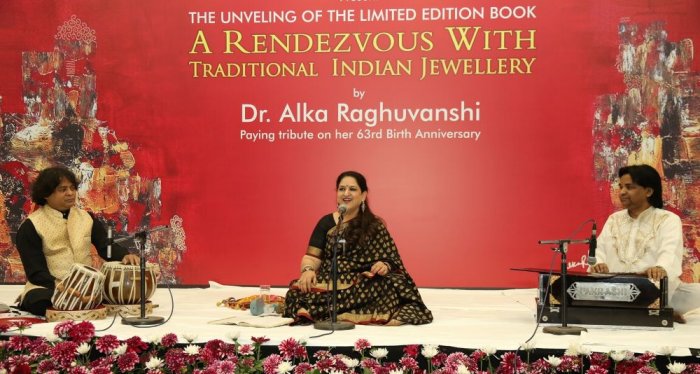 Amjad Khan on tabla, Ghazal singer Radhika Chopra, Nafeez Ahmed on harmonium The book launch and Award ceremony were followed with music by Radhika Chopra, the Ehsaas star awardee, who gave a special performance in memory of Alka Raghuvanshi. Opening with the popular number of the young Akhtari Bai Faizabadi, "Na socha na samjha, na seekha na jaana / Mujhe aa gaya khud-ba-khud dil lagaana", she followed it up with Ghalib's "Hazaaron khwaahishen aisi ke har khwahish pe dum nikle / Bahut nikle mere armaan lekin phir bhi kam nikle". It was a short but sweet selection of Alka's choicest Ghazals presented by Radhika, in her emotion charged voice as a beautiful bouquet. PRATISHRUTI FOUNDATION'S GOPINI PREM Photos: Rahul Naag Shrimanto Sankardeva, the saint poet of the 15th-16th century Bhakti movement, brought neo-Vaishnavism to Assam through his Advaita philosophy of 'Eka Sharan Hari Naam Dharma'. The great Master created a large corpus of work along with his ace disciple Madhavdeva. With the aim to popularize and propagate the enormous work of the polymath who composed dance-dramas, music, art and craft, practised till date in the Sattras of Assam, Sattriya exponent Prateesha Suresh and her Pratishruti Foundation have been working tirelessly. 'Gopini Prem' was their recent presentation based on the Borgeet songs of Sankardeva in all hues of Bhakti, the Gopis felt for their beloved Krishna. These Borgeets have been sung, danced and emoted to by the Sattriya artistes for a long time, but Prateesha's idea was to popularise them in other classical dance forms too. She got them interpreted through Mohiniyattam, Odissi and Sattriya dance styles recently at the Stein Auditorium of the India Habitat Centre, Delhi. The Bhakti rasa and the lyrical beauty of these compositions were categorised content-wise under Dasya Bhava, Madhurya Bhava, Vatsalya Bhava and Sakhya Bhava, bringing in different facets of Krishna's relationship with the Gopinis of Brijbhumi. 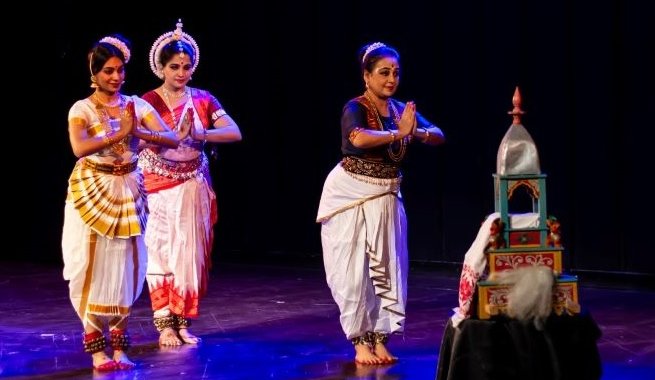 Gopini Prem The evening evoked devotional fervour right from the beginning when the three dancers Prateesha Suresh in Sattriya, Aneri Sheth in Mohiniyattam and Rasika Gumaste in Odissi, carried forth the palanquin decked with the Assamese Gamchhas, waving whisks with respect, singing 'Jaya Guru Shankara Deva' tuned to the typical Assamese melody based on raga Bhoop or Mohanam and chanting 'Govinda Govinda', which further became a demarcating symbol of different dance styles carrying forward the storyline. Prateesha Suresh presented the first Borgeet "Chor Dhora" in Sattriya style depicting the vatsalya bhava. This composition of Madhavdeva was taken from the dance-drama Chor Dhora. The Makhan Chori Leela of child Krishna was emoted by Prateesha with motherly love where Krishna is caught red-handed while stealing butter with his friends and was reprimanded for his mischief. Prateesha is a seasoned actor of Ankiya Nat as well, which could be seen in her ekaharya abhinaya playing multiple characters convincingly. Aneri Sheth, a senior disciple of Guru Mandakini Trivedi, was the Mohiniyattam dancer who danced to the Borgeet "Brojo Romoni Khonge" treating Krishna in a friendly way where she plans along with other Gopinis to steal his flute, his Kaustubh Mala, his Kundala (earrings), the bangles and his Peetambara etc and let him come to them begging to return all that. The poet writes, "It is his Leela that he allows them to tease him like this, to let them experience the ecstatic devotion with no bars of hierarchy." 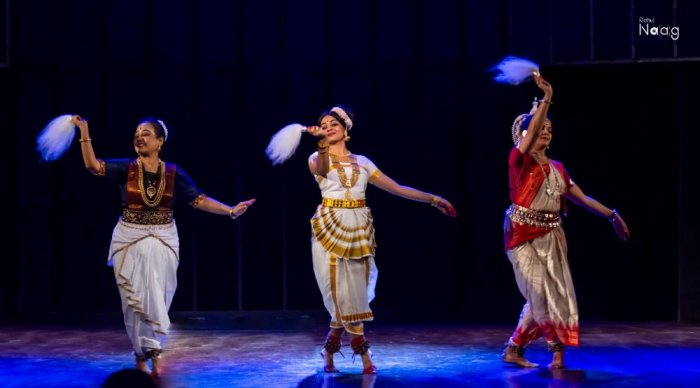 Gopini Prem Madhurya bhava was portrayed by Rasika Gumaste in Odissi dance style on "O Re Sakhi", where the Gopi enchanted by Krishna's beauty describes how each aspect of Nandagopal's beauty is so uniquely sweet. The opening aalap on sitar in Madhamad Sarang and flute in Megh Malhar created the desired romantic aura, using sargams and rhythmic patterns of pallavi suiting the sahitya. Prateesha concluded with dasya bhava on Kubja, the hunchbacked Dasi's mythological story, beautifully portrayed through moving abhinaya. The use of the Keertan style "Govinda Govinda" danced by all three dancers in-between the different Borgeets was thoughtfully used for the change of scenes. Each of the three classical dance styles had authentic music and musical instruments. Khol and flute for Sattriya for instance; maddalam, edakka and veena for Mohiniyattam; and sitar flute and pakhawaj for Odissi. All the instruments like the flute, violin, kohl, mardal, mridanga, and edakka etc for the group chorus on "Govina Govinda", was commendable to create the devotional fervour of the Sattras. It was a novel experience for Delhi music and dance lovers. 53RD ALL INDIA BHASKAR RAO NRITYA SANGEET SAMMELAN, CHANDIGARH Photos courtesy: Pracheen Kala Kendra Organized annually by Pracheen Kala Kendra in memory of Bhaskar Rao Bakhle (1869-1922), the versatile Hindustani classical musician, composer and Guru, the All India Bhaskar Rao Dance and Music Festival has been pulling music and dance lovers of Chandigarh for more than half a century. The 53rd All India Bhaskar Rao Nritya Sangeet Sammelan was held at the Tagore Theatre, Chandigarh from the 15th to the 24th of March, ten days at a stretch. Bharatanatyam by Rama Vaidyanathan and disciples on the inaugural evening and Kathak by Vidha Lal and troupe on the concluding evening gave the ten-day festival a judicious blend of classical music and dance. 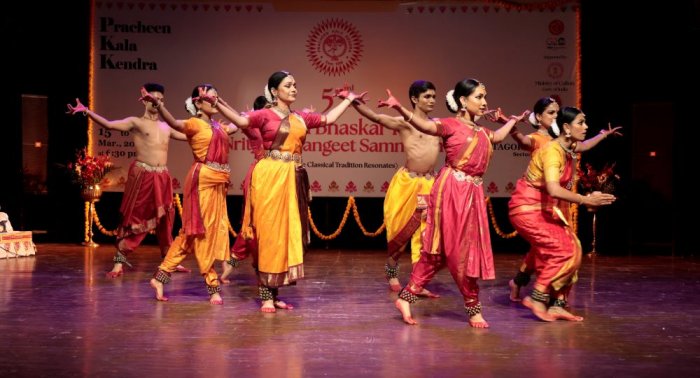 Rama Vaidyanathan and group After the soulful violin recital of Deepak Pandit playing raga Kirwani and Punjab Ang ki Bhairavi, the inaugural evening showcased Bharatanatyam by Rama Vaidyanathan and her well-trained disciples commencing with 'Pratibodhitam'. Opening with the invocatory Thiruvempavai, Pratibodhitam was a thought-provoking theme for the allegorical portrayal of how waking up from your sleep is a metaphor for waking up from the slumber of ignorance to the light of supreme consciousness. The music of this piece was imaginatively composed by Sudha Raghuraman. The second presentation was 'Kashi', describing and depicting the sacred city of Benaras, where people go in search of truth and liberation. This is the space that gives you inner bliss, freedom and joy. Lord Visveswara resides in Kashi, where life and death both are celebrated by the banks of the river Ganga. Yogis and Aghoris renounce mundane life and come here searching for spiritual realization. Rama concluded her presentation with 'Raas Mandala', based on a Surdas Bhajan depicting the 'circle' as a symbol of unending life and continuity. Raas Mandala which is always a circle of vibrant dancing, symbolized it beautifully. Dancers of her troupe were Pritam Das, Nilav Sen, Shubhamani, Vaishnavi, Reshavi, Keerthana, Rohini and Sowmya. Music accompaniment comprised Sudha Raghuraman on vocal, Himanshu Srivastava on nattuvangam, Sannidhi Vaidyanathan on mridangam, G Raghuraman on flute, whereas lights were handled by Jaya Seal.  Kiran Segal's disciples Odissi dance performance by Guru Kiran Segal and her disciples was the dance attraction of the second evening. Kiran Segal's disciples took the stage after the Hindustani vocal recital by Amjad Ali Khan, the talented disciple of Ud. Mashkoor Ali Khan of Kirana Gharana, the resident Guru at the ITC Sangeet Research Academy (SRA), Kolkata. Opening with Mangalacharan invoking Devi Saraswathi, the goddess of music and learning, the Odissi group moved on to present Sthai, the pure dance number depicting sculpturesque poses from the temples of Odisha. This was followed by Hamsadhwani Pallavi, a superb combination of melody and rhythm, choreographed by Kiran Segal. "Jago Maheshwara" came as their abhinaya piece. The accompanying orchestra had Prafulla Mangaraj on mardal, Prashant Behera on vocal, Dheeraj Pandey on flute, Rais Ahmad on sitar and Kiran Segal conducting the melodious orchestra with manjeera. The well-groomed dancers comprised Madhyama Segal, Sangini Kumar, Akanksha Roy, Maitri Pal, Samiksha Roy Choudhary, Aditi Gupta and Janhavi Kallonini. 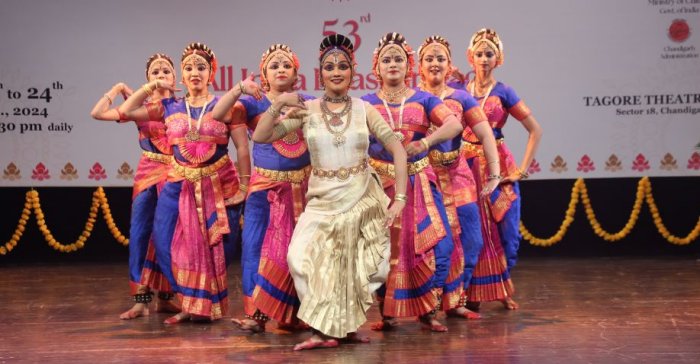 Meenu Thakur and group Kuchipudi dance by Meenu Thakur and troupe was performed a day after. The invocatory Ganesh Vandana was followed by a captivating Kuchipudi dance drama 'Navagraha Charitam' depicting the power, evolution, nature and the effect of planetary motion through the stories about the nine planets according to Hindu mythology explored through the intricacies of rhythm and natya. The Navagrahas comprised Surya (Sun), Chandra (Moon), Mangal (Mars), Budha (Mercury), Brihaspathi (Jupiter), Shukra (Venus), Shani (Saturn), Rahu (North Lunar Mode) and Ketu (South Lunar Mode). The impressive portrayal of their nature, power, position, and impact was showcased through the aesthetics of Rasas. If Surya, the king of planets, riding on a seven-horsed chariot, illuminated the whole world, the Chandra soothed the anger. The zeal of Mangal riding swiftly on the horned ram, or the wisdom of Budh on a lion's back, in equal measure. The righteousness of Guru firmly seated on an elephant, or Shukra in a state of shringara rasa riding a horse, Shani in all his destructive wrath, and Rahu and Ketu on the backs of a tiger and a pigeon respectively, were an indelible part of the different stories enacted. Meenu Thakur's Navagraha Charitam was presented on recorded music. Her group had young artistes like Garima Prakash, Bhawana Gill, Tanushree Biswas, Riya, Pritika, Saisha Wallia, Sai Tejasvi, Manasi Gola, Rahul Roy and Nitin. 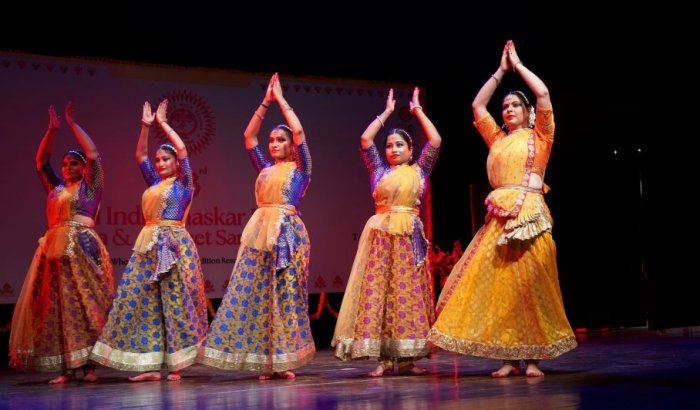 Vidha Lal and group Vidha Lal and her dance troupe enthralled the audience with their captivating Kathak performance on the concluding night. They started with the invocation to Maa Durga with the Beej Mantra "Om Aiyeem Hreem Kleem Chamundaye Vichchhe" beautifully describing the three feminine powers. This invocatory item was composed by Guru Geetanjali Lal, and choreographed by Vidha Lal. The second rendition was 'Ullas' based on the popular composition "Albela sajan aayo ri" for the Bhav Paksha, the expressional aspect. The beautiful portrayal of Radha-Krishna's love saga through this Bandish in raga Ahir Bhairav was thoroughly enjoyed by the audience. The 'Hori Dhamar' was presented in a solo format by Vidha Lal. The vibrant depiction of Radha Krishna playing Holi, her beautiful abhinaya was an equitable combination of facial expressions, and lyrical body movements. The flawless footwork also got her repeated applause. Vidha Lal and troupe concluded with the exuberant 'Rang', "Aaj rang hai" a Sufi composition of Amir Khusro. Muskaan, Stuti Pandey, Nidhi Kakkar and Anamika Mandal participated in the group choreographies of Vidha Lal. The live music accompaniment was provided by Hiren Chate on tabla, Salman Warsi on pakhawaj, Suheb Hasan on vocal, and Aamir Khan on sarangi. 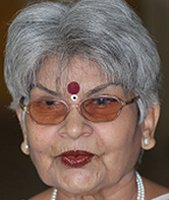 Manjari Sinha has an M.A. in Sanskrit and Music, and Sangeet Prabhakar in vocal, tabla, sitar and Kathak dance. She has regular columns in national dailies as a music and dance critic. |